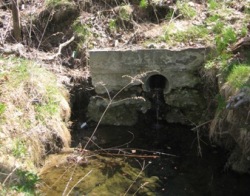They expressed concerns ranging from safety, such as unpredictable weather patterns and dangerous ice conditions, to changes in plants and animals as well as decreased availability of firewood.

Stanford researchers have gotten a glimpse into an uncertain future where increasing levels of carbon dioxide in the Earth's atmosphere will lead to higher levels in the ocean as well, leaving the water more acidic and altering underwater ecosystems.
The state-of-the-art biomass gasification system will provide clean, carbon-neutral heat and power to the medical center.
It seems fuel economy is on everyone's minds these days. The Metropolitan Transit Authority of Harris County, with its large bus fleet, is no exception.
La Niña, which contributed to extreme weather around the globe during the first half of 2011, has re-emerged in the tropical Pacific Ocean and is forecast to gradually strengthen and continue into winter.
How can legislation be used to avoid hazardous waste being dumped where it could poison people and the environment in developing countries? Introducing producer responsibility could be one solution, says Panate Manomaivibool of the International Institute for Industrial Environmental Economics (IIIEE) at Lund University, Sweden, in a new thesis.
Legend tells of Greek engineer and inventor Archimedes using parabolic mirrors to create "heat rays" to burn the ships attacking Syracuse. Though the underpinnings of that claim are speculative at best, a modern-day team of researchers at the Scientific and Production Association in Uzbekistan has proposed a more scientifically sound method of harnessing parabolic mirrors to drive solar-powered lasers.
BUSolutions LCO-140H to revitalize urban transit by increasing fuel economy by 110 percent and reducing 12-year fleet operations cost by $50 million for the average sized transit authority.
The new UNTHA Recycling Technology (URT) system at the Appliance Recycling Centers of America (ARCA)’s facility in Philadelphia is ready to begin recycling as many as 150,000 refrigerators annually, GE and ARCA announced Sept. 9.
Hurricane Irene and heavy rains across the East Coast have caused major flooding. Here are a few tips on what to do if your house meets with some of the floodwaters.
University of Iowa researchers have found high levels of toxic polychlorinated biphenyls (PCBs) in the deep sediments lining the Indiana Harbor and Ship Canal (IHSC) in East Chicago, Ind.

Phase II stormwater permit renewals to require investments in time and resources.
The U.S. Environmental Protection Agency is proposing to approve the 8-hour ozone air quality plans for the San Joaquin Valley and South Coast areas. These plans, known as State Implementation Plans, are the roadmaps to meeting the Clean Air Act standard of 0.08 parts per million of ozone as measured in 8-hour increments.
The Florida Fish and Wildlife Conservation Commission recently partnered with Fishing for Energy to remove derelict stone crab traps from the marine environment near Everglades City, Fla., making it the second location in Florida to join the unique partnership.
Boston University researchers have estimated that even if international efforts to limit temperature increases to 2 degrees Celcius, mean global temperatures will continue to be extreme.
Restoring prairies to their native vegetation can be approached from several directions. Managers might eliminate invasive plants through use of herbicides, encourage growth of native species through seeding, or manipulate conditions to favor native species.
Trees can reveal key information about fire events, and some trees have a lot to tell — one tree researchers examined endured 14 separate fires through its lifetime.
Although the burning of natural gas emits far less carbon dioxide than coal, a new study concludes that a greater reliance on natural gas would fail to significantly slow down climate change. The study appears this week in the Springer journal Climatic Change Letters.
RadioShack collects 5-million pounds of rechargeable batteries.

A pilot waste-to-energy system recently constructed by Duke University and Duke Energy garnered the endorsement of Google Inc., which invests in high-quality carbon offsets from across the nation to fulfill its own carbon neutrality goals.